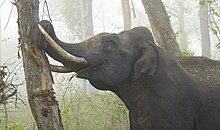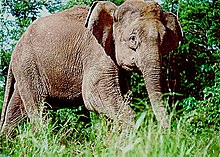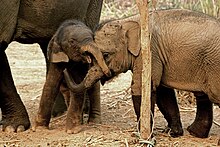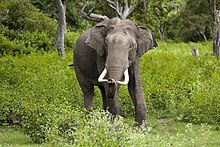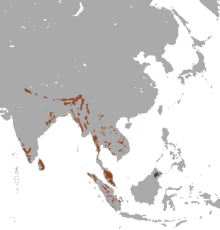হাতী (ইংৰাজী : Asian or Asiatic elephant Elephas maximus ) এলিফাছ (Elephas) ভাৰত ৰ পৰা পূবেবৰ্ণিঅ' লৈকে বিস্তৃতি হৈ আছে।[ 1] [ 4]
১৯৮৬ চনৰ পৰাই হাতীক আই. ইউ. চি এন ৰ ৰেড ডাটা বুকত সংকটাপন্ন বুলি স্বীকৃতি দিয়া হৈছে। যোৱা তিনিটা দশত ইয়াৰ জনসংখ্যা প্ৰায় ৫০% হ্ৰাস হোৱা বুলি জানিব পৰা গৈছে। ইয়াৰ স্থিতিৰ প্ৰতি প্ৰধান ভাবুকিবোৰ হৈছে-বনাঞ্চল ধ্বংস, মানুহৰ সৈতে সংঘাত ইত্যাদি।[ 3] [ 5]
Illustration of an elephant skeleton[ 6] ভাৰতীয় হাতী সাধাৰণতে আফ্ৰিকাৰ হাতীতকৈ আকাৰত সৰু। ইয়াৰ পিঠি অংশ হঠঙা। কাণ দুখন সৰু আৰু সন্মুখৰ ফালে ভাঁজ খোৱা। মতা হাতীৰ কান্ধলৈকে উচ্চতা ২.৭ মিটাৰ (৯ ফুট) আৰু মাইকী হাতীৰ প্ৰায় ২.৮ মিটাৰ (৮ ফুট)[ 6] [ 4] [ 7]
হাতীৰ শুঁৰে চাৰি লিটাৰ পৰ্যন্ত পানী ধৰি ৰাখিব পাৰে। ই শুঁৰডালেৰে অন্য হাতীৰ সৈতে খেলে কিন্তু প্ৰকৃত যুঁজত ই কেৱল ভাবুকি দিবলৈহে ইয়াক ব্যৱহাৰ কৰে।[ 8]
Tusker debarking a tree হাতীৰ দাঁত ই পানী, লোণ আদি গছৰ গা বা শিলৰ ফাঁকৰ পৰা উলিয়াবলৈ ব্যৱহাৰ কৰে।[ 4] [ 9]
[ 10]
Depigmented skin on the forehead and ears of an Asian elephant Tusker at Corbett National Park taking a mud bath
Sri Lankan elephants Borneo elephant জীৱবিজ্ঞানী কাৰ্ল লিনিয়াছে পোনপ্ৰথমে ১৭৫৮ চনত 'Elephas' গোত্ৰ আৰু ' ৰ বিষয়ে উল্লেখ কৰিছিল[ 11] Georges Cuvier ) প্ৰথম ভাৰতীয় হাতীক Elephas indicus নামেৰে বৰ্ণনা কৰিছিল।[ 12] Coenraad Jacob Temminck ) সুমাত্ৰাৰ হাতীক Elephas sumatranus নামেৰে নামকৰণ কৰে । .[ 13]
হাতীৰ প্ৰধানত: তিনিটঅ উপ-প্ৰজাতি পোৱা যায়-[ 3] [ 4]
শ্ৰীলংকাৰ হাতী (Sri Lankan elephant _- শ্ৰীলংকা
ভাৰতীয় হাতী ( Indian elephant ) -ভাৰত, নেপাল, বাংলাদেশ, ভূটান, ম্যানমাৰ , থাইলেণ্ড, ভিয়েটনাম, কম্বোডিয়া, লাওছ, চীন l
সুমাত্ৰাৰ হাতী ( Sumatran elephant )- সুমাত্ৰা, বৰ্ণিঅ' তদুপৰি অন্য দুবিধ বিলুপ্ত উপ-প্ৰজাতি হৈছে-
A herd of elephants in the grasslands of Jim Corbett National Park A herd of elephants in the Nagarahole National Park এছিঅ' হাতীয়ৈ সাধাৰণতে ঘাঁহনি, ক্ৰান্তীয় চিৰসেউজীয়া বনাঞ্চল (tropical evergreen forests ), অৰ্ধ-চিৰসেউজীয়া বনাঞ্চল (semi-evergreen forests), সেমেকা পৰ্ণপাতী বনাঞ্চল (moist deciduous forests ), শুকান পৰ্ণপাতী বনাঞ্চল (dry deciduous forests) আৰু শুকান কাইঁটীয়া বনাঞ্চল (dry thorn forests) ত বাস কৰে। তদুপৰি ইয়াক খেতি-পথাৰ আদিতো চৰা দেখিবলৈ পোৱা যায়। এই বনাঞ্চলসমূহত সাধাৰণতে সাগৰপৃষঠৰ পৰা ৩,০০০ মিটাৰ উচ্চতা পৰ্যন্ত হাতীক বাস কৰা দেখা পোৱা যায়।[ 14]
A 5-month-old calf and its 17-month-old cousin in a sanctuary in Laos হাতী সাধাৰণতে দোকমোকালি আৰু গধূলি সময়ত আটাইতকৈ সক্ৰিয় (crepuscular )।[ 4] megaherbivores ) হিচাপে শ্ৰেণীভুক্ত কৰা হৈছে। ই দৈনিক প্ৰায় ১৫০ কি.গ্ৰা. উদ্ভিদ খাব পাৰে।[ 15] grazers ' আৰু 'browser' দুয়োবিধ পদ্ধতিৰেই খাদ্য গ্ৰহণ কৰে। গৱেষণাত ই প্ৰায় ১১২ বিধ বিভিন্ন উদ্ভিদৰ প্ৰজাতি খাদ্য হিচাপে গ্ৰহণ কৰে বুলি জানিব পৰা গৈছে।[ 16] [ 4]
পূৰ্ণবয়স্ক মাইকী হাতী আৰু কমবয়সীয়া হাতীয়ে দলত একেলগে চৰে। কিন্তু পূৰ্ণতাপ্ৰাপ্তিৰ লগে লগে মতা হাতীয়ে মাকৰ লগ এৰে। ইহঁতে কেতিয়াবা অকলশৰে বা অন্য সময়ত অন্য সমবয়সীয়া মতা হাতীৰ সৈতে দল ('bachelor groups') গঠন কৰি চৰে।[ 17]
মাক-পোৱালিৰ দলত সাধাৰণতে তিনিজনী মান পূৰ্ণবয়স্ক মাইকী হাতী পোৱালিৰে সৈতে থকা দেখা যায়।[ 18] [ 19] [ 20] [ 19]
হাতীৰ উচ্চ কম্পনাংকৰ শব্দ শুনাৰ ক্ষমতা আছে।[ 21]
Indian elephants in the Coimbatore Forests, Tamil Nadu মতা হাতীয়ে মাইকী হাতীৰ সৈতে প্ৰজনন কৰাক লৈ ইটোৱে সিটোৰ সৈতে যুঁজ কৰে। সাধাৰণতে মতা হাতীয়ে ১২-১৫ বছৰৰ ভিতৰত পূৰ্ণবয়স্ক হয়। ১০ ৰ পৰা ২০ বছৰ বয়সৰ ভিতৰত মতা হাতীৰ বছৰেকীয়াভাৱে “musth ” আৰম্ভ হয়। এই সময়ছোৱাত হাতীৰ দেহত অন্য স্বাভাৱিক সময়ৰ তুলনাত প্ৰায় ১০০ গুণ বেছিকৈ টেষ্ট'ষ্টেৰণ হৰ্মন ক্ষৰণ হয়। ইয়াৰ ফলত হাতী এই সময়ত অতি খঙাল আৰু উত্তেজিত হৈ উঠে। হাতীৰ মূৰত চকুৰ কাষত থকা paired temporal gland এই সময়ছোৱাত ফেৰমণ (pheromone ) ক্ষৰণ কৰে।[ 22]
হাতীৰ গৰ্ভধাৰণ কাল প্ৰায় ১৮-২২ মাহ। মাইকী হাতীয়ে এটা বা কেতিয়াবা যুঁৰীয়া পোৱালি জন্ম দিয়ে। ১৯ মাহৰ ভিতৰত পোৱালিয়ে গৰ্ভত সম্পূৰ্ণ ৰূপ পায়। জন্মৰ সময়ত পোৱালিৰ ওজন প্ৰায় ১০০ কি.গ্ৰা. হয়। [উদ্ধৃতিৰ প্ৰয়োজন
হাতীৰ জীৰনকাল সাধৰণতে গড়ে ৬০ বছৰ হয়। অৱশ্যে কৃত্ৰিম পৰিৱেশত ই ৮০ বছৰ পৰ্যন্ত জীয়াই থকাও দেখা পোৱা যায়।[ 4]
Prime elephant habitat cleared for jhum shifting cultivation practiced in Arunachal Pradesh মানুহ আৰু হাতীৰ মাজৰ সংঘাতৰ মূল কাৰণ হৈছে বাসস্থানৰ বাবে প্ৰতিযোগিতা। বেদখল, খেতি পথাৰ আদিৰ বাবে কৰা বনাঞ্চল ধ্বংসই হাতীৰ বাবে সংকট মাতি আনিছে। প্ৰয়োজনীয়া খাদ্যৰ সন্ধানত হাতীৰ বৃহৎ জাকে বনাঞ্চলৰ সীম মূৰীয়া খেতি-পথাৰৰ মাজেদি গৈ তহিলং কৰিলেই মানুহৰ সৈতে সংঘাত সৃষ্টি হয়।[ 23]
↑ 1.0 1.1 সাঁচ:MSW3 Proboscidea ↑ উদ্ধৃতি ত্ৰুটি: অবৈধ <ref> টেগ;
Haynes1993 নামৰ refৰ বাবে কোনো পাঠ্য প্ৰদান কৰা হোৱা নাই ↑ 3.0 3.1 3.2 Choudhury, A., Lahiri Choudhury, D.K., Desai, A., Duckworth, J.W., Easa, P.S., Johnsingh, A.J.T., Fernando, P., Hedges, S., Gunawardena, M., Kurt, F., Karanth, U., Lister, A., Menon, V., Riddle, H., Rübel, A., Wikramanayake, E. (2008). "Elephas maximus" . IUCN Red List of Threatened Species. Version 2010.4International Union for Conservation of Nature . http://www.iucnredlist.org/apps/redlist/details/7140 . ↑ 4.0 4.1 4.2 4.3 4.4 4.5 4.6 Shoshani, J, Eisenberg, J. F. (1982). "Elephas maximus" . Mammalian Species খণ্ড 182 : 1–8. doi :10.2307/3504045 . Archived from the original on 2013-04-30. https://web.archive.org/web/20130430131057/http://www.science.smith.edu/msi/pdf/i0076-3519-182-01-0001.pdf । আহৰণ কৰা হৈছে: 2013-08-26 . ↑ Sukumar, R. (2003). The Living Elephants: Evolutionary Ecology, Behavior, and Conservation . http://books.google.com/books?hl=en&lr=&id=P_IS80OBWTgC&oi=fnd&pg=PA1&ots=VS04CbKb15&sig=yhJWx6IDJ4hE8qRWCVEuBAdqXb4 . ↑ 6.0 6.1 Lydekker, R. (1894). The Royal Natural History. Volume 2 . http://www.archive.org/stream/royalnaturalhist02lydeuoft#page/542/mode/2up . ↑ Rasmussen, L. E. L. (2006) Chapter 32. Chemical, Tactile, and Taste Sensory Systems . In: Fowler, M. E., Mikota, S. K. Biology, medicine, and surgery of elephants . Wiley-Blackwell, Oxford, UK. ISBN 978-0-8138-0676-1 . Page 409 ff.
↑ Spinage, C. A. (1994). Elephants . প্ৰকাশক London: T & A D Poyser. ISBN 0856610887 . ↑ Clutton-Brock, J. (1987). A Natural History of Domesticated Mammals . প্ৰকাশক London: British Museum (Natural History). পৃষ্ঠা. 208. ISBN 0-521-34697-5 . ↑ Aldous, P. (2006-10-30). "Elephants see themselves in the mirror" . New Scientist. http://www.newscientist.com/article/dn10402-elephants-see-themselves-in-the-mirror.html . ↑ Linnaei, C. (1760) Elephas maximus Caroli Linnæi Systema naturæ per regna tria naturæ, secundum classes, ordines, genera, species, cum characteribus, differentiis, synonymis, locis . Tomus I. Halae Magdeburgicae. Page 33
↑ Cuvier, G. (1798) Tableau elementaire de l’histoire naturelle des animaux
↑ Temminck, C. J. (1847) Coup-d'oeil général sur les possessions néerlandaises dans l'Inde archipélagique. Tome second
↑ Choudhury, A. U. (1999) Status and Conservation of the Asian elephant Elephas maximus in north-eastern India . Mammal Review 29: 141–173.
↑ Samansiri, K. A. P.; Weerakoon, D. K. (2007). "Feeding Behaviour of Asian Elephants in the Northwestern Region of Sri Lanka" . Gajah: Journal of the IUCN/SSC Asian Elephant Specialist Group খণ্ড 2 : 27–34. http://www.asesg.org/PDFfiles/Gajah/27-27-Samansiri.pdf . ↑ Sukumar, R. (1990). "Ecology of the Asian Elephant in southern India. II. Feeding habits and crop raiding patterns" . Journal of Tropical Ecology খণ্ড 6 : 33–53. Archived from the original on 2007-10-12. https://web.archive.org/web/20071012123045/http://www.asiannature.org/pdf_resources/JournalofTropicalEcologyB1989.pdf । আহৰণ কৰা হৈছে: 2013-08-26 . ↑ McKay, G. M. (1973). "Behavior and ecology of the Asiatic elephant in southeastern Ceylon". Smithsonian Contributions to Zoology খণ্ড 125 : 1–113. ↑ Fernando, P.; Lande, R. (2000). "Molecular genetic and behavioral analysis of social organization in the Asian elephant (Elephas maximus )". Behav Ecol Sociobiol খণ্ড 48 (1): 84–91. doi :10.1007/s002650000218 . ↑ 19.0 19.1 de Silva, S.; Wittemyer, G. (2012). "A Comparison of Social Organization in Asian Elephants and African Savannah Elephants". International Journal of Primatology খণ্ড Forthcoming . doi :10.1007/s10764-011-9564-1 . ↑ de Silva, S.; Ranjeewa, A. D. G.; Kryazhimskiy, S. (2011). "The dynamics of social networks among female Asian elephants". BMC Ecology খণ্ড 11 : 17. doi :10.1186/1472-6785-11-17 . ↑ Heffner, R.; Heffner, H. (1980). "Hearing in the elephant (Elephas maximus )". Science 208 (4443): 518–520. doi :10.1126/science.7367876 . ↑ Jainudeen, M. R.; McKay, G. M.; Eisenberg, J. F. (1972). "Observation on musth in the domesticated Asiatic elephant (Elephas maximus)". Mammalia খণ্ড 36 (2): 247–261. doi :10.1515/mamm.1972.36.2.247 . ↑ Barua, M. (2010), Whose issue? Representations of human-elephant conflict in Indian and international media , https://docs.google.com/viewer?a=v&pid=sites&srcid=ZGVmYXVsdGRvbWFpbnxtYWFuYmFydWF8Z3g6MzA5MTlkMjU2YjllMWVhMw
Gilchrist, W. (1851) A Practical Treatise on the Treatment of the Diseases of the Elephant, Camel & Horned Cattle: with instructions for improving their efficiency; also, a description of the medicines used in the treatment of their diseases; and a general outline of their anatomy . Calcutta: Military Orphan Press
Miall, L. C., Greenwood, F. (1878). Anatomy of the Indian Elephant . http://www.archive.org/details/anatomyofindiane00mial . Barua, M., Tamuly, J. and Ahmed, R.A. (2010) Mutiny or Clear Sailing? Examining the Role of the Asian Elephant as a Flagship Species
Barua, M. (2010) Whose issue? Representations of human-elephant conflict in Indian and international media

